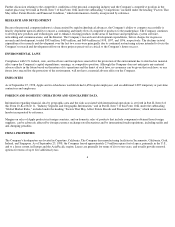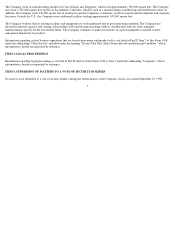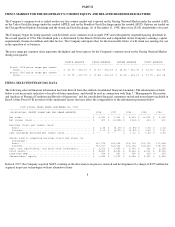Apple 1998 Annual Report Download - page 17
Download and view the complete annual report
Please find page 17 of the 1998 Apple annual report below. You can navigate through the pages in the report by either clicking on the pages listed below, or by using the keyword search tool below to find specific information within the annual report.$7 million. At the time an equity method investee sells existing or newly issued common stock to unrelated parties in excess of its book value,
the equity method requires that the net book value of the investment be adjusted to reflect the investor's share of the change in the investee's
shareholders' equity resulting from the sale. Consequently, the Company also recognized in the third quarter of 1998 other income of
approximately $16 million to reflect its remaining 25.9% ownership interest in the increased net book value of ARM following its initial public
offering. As of September 25, 1998, the carrying value of the Company's investment in ARM was approximately $22 million. The fair value of
this investment as of September 25, 1998, based on listed market quotes was approximately $186 million.
On October 14, 1998, the Company sold an additional 2.9 million shares of ARM stock for net proceeds of approximately $37.5 million and a
gain before foreign taxes of approximately $32 million, which will be recognized as other income by the Company in the first quarter of fiscal
1999. As a result of this sale, the Company's ownership interest in ARM has fallen to 19.7%, and the Company no longer has significant
influence over the management or operating policies of ARM. Consequently, beginning in the first quarter of fiscal 1999, the Company will no
longer account for its remaining investment in ARM using the equity method and has categorized its remaining shares as available for sale
requiring they be carried at fair value, with future unrealized gains and losses reported as a component of shareholders' equity. Subsequent to
the sale of shares, on October 14, 1998, the carrying value of the Company's investment in ARM was approximately $17 million, and the fair
value, based on listed market quotes, was approximately $135 million.
During 1998, the Company experienced a $27 million increase in interest income net of interest expense as a result of higher cash and
investment balances and lower average short-term borrowings that was offset by decreased foreign exchange gains and increased other
expense.
Interest and other income (expense), net, decreased to $25 million in 1997 from $88 million in 1996. The decrease was primarily due to gains
realized in 1996 on sales of available-for-sale and other securities and decreased foreign exchange gains in 1997 compared to 1996 partially
offset by higher average cash balances during 1997.
PROVISION (BENEFIT) FOR INCOME TAXES
As of September 25, 1998, the Company had deferred tax assets arising from deductible temporary differences, tax losses, and tax credits of
$688 million before being offset against certain deferred tax liabilities for presentation on the Company's balance sheet. A substantial portion of
this asset is realizable based on the ability to offset existing deferred tax liabilities. As of September 25, 1998, a valuation allowance of $213
million was recorded against the deferred tax asset for the benefits of tax losses that may not be realized. Realization of approximately $73
million of the asset representing tax loss and credit carryforwards is dependent on the Company's ability to generate approximately $209
million of future U.S. taxable income. Management believes that it is more likely than not that forecasted U.S. income, including income that
may be generated as a result of certain tax planning strategies, will be sufficient to utilize the tax carryforwards prior to their expiration in 2011
and 2012 to fully recover this asset. However, there can be no assurance that the Company will meet its expectations of future U.S. taxable
income. As a result, the amount of the deferred tax assets considered realizable could be reduced in the near and long term if estimates of future
U.S. taxable income are reduced. Such an occurrence could materially adversely affect the Company's consolidated financial results. The
Company will continue to evaluate the realizability of the deferred tax assets quarterly by assessing the need for and amount of the valuation
allowance. The Company's effective tax rate for fiscal 1998 was only 6.1% due primarily to the reversal of a portion of the previously
established valuation allowance and certain undistributed foreign earnings for which no U.S. taxes were provided.
The Internal Revenue Service (IRS) has proposed federal income tax deficiencies for the years 1984 through 1991, and the Company has made
certain prepayments thereon. The Company contested the
15
























